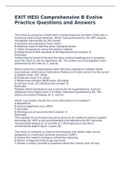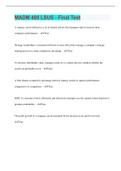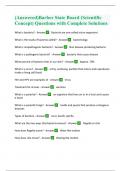Fool. (To help, focus only on A1S4, A1S5, A2S4, A3S2 and A3S4)
The story of Shakespeare’s ‘King Lear,’ portrays the Lear’s downward spiral into madness after he
hands parts of his kingdom away to those who have ulterior motives against him. Lear loses the
support of his daughters and their husbands, however his Fool remains loyal to him. In doing so,
Shakespeare’s presentation of the relationship between Lear and the Fool may serve as a
commentary on madness. He explores their relationship as akin to a father-son bond, whilst
conversely showing it as antagonistic and critical. Shakespeare also portrays the inverted roles of
their relationship that occurs as Lear loses grip of his sanity.
The Fool and Lear are presented as having an almost father-son like relationship allowing
Shakespeare to compare Lear’s relationship with his actual daughters to his relationship with the
Fool. Upon the Fool’s introduction in the A1S4, Lear refers to him affectionately, calling him, “my
pretty knave,” and asking, “how doust thou?” The possessive pronoun, “my,” is quite personal and
serves a stark contrast to how he refers to his daughters, calling them simply, “daughter,” which
seems detached and impersonal. Additionally, Shakespeare makes use of assonance in the endearing
term, "my pretty knave," which is featured in the repetition of the "I" sound in both "my" and
"pretty." This adds a sense of harmony and musicality to the phrase, which heightens the fondness
and lightness of the Fool and Lear’s relationship. The personal relationship between the Fool and
Lear goes both ways as the Fool repeatedly calls Lear, “nuncle,” which implies a sense of familiarity
between the two. Lear’s fondness for the Fool, which is requited, may be influenced by James VI’s
fondness for younger male company. James had various personal relationships with mistresses and
younger, male courtiers and James lavished affection of his protestor, Esme Stewart. Whilst there is
no evidence of a homosexual relationship, the Fool could be said to reflect James’ own close
relationship with his guardian, his cousin, Esme Stuart, which is shown in Lear and the Fool’s strong
bond. Additionally, the way Lear refers to the Fool allows Shakespeare to contrast how Lear talks to
Goneril later in the scene, too, calling her a, “degenerate bastard.” The consonant sounds used in
this derogatory name, for example the "d" and "g" in "degenerate" and the "b" sounds in "bastard,”
have a harsh and percussive quality to it. This helps emphasise the forceful and condemning nature
of the phrase, whilst juxtaposing the soft, musical sounds from, “my pretty knave.” Arguably, both
Goneril and the Fool have treated Lear poorly in this scene, for example the Fool outwardly calls Lear
a, “fool,” which disrespects his authority as a King. However, Lear continues to humour the Fool and
curses Goneril for her words. This could be symptomatic of the fact that Lear’s daughters are defying
their conventional gender norms of being submissive and caring women by challenging him,
garnering resentment in Lear towards the pair, as well as in the audience who may condemn the
treachery the daughters are showing to their father. Thus, this reinforces the Fool and Lear’s close,
familial bond. This is further seen in the pivotal storm scene where the affection Lear shows to the
Fool is heightened as he says to the fool, “Come on, my boy. How dost, my boy? Art cold? I am cold
myself.” Though the repetition of questions and the phrase, “my boy,” in such quick succession is
revealing of Lear’s declining mental state, it effectively shows how Lear is able to show concern for
the Fool even when his sanity is slipping which strengthens Shakespeare’s portrayal of their bond as
a father-son relationship. In light of Lear’s rejection from his family, in showing the strength of their
relationship as the Fool remains by his side, Shakespeare may be displaying the power of loyalty and
how madness shouldn’t equate to poor treatment, contrary to the way Goneril and Regan have
treated Lear.






